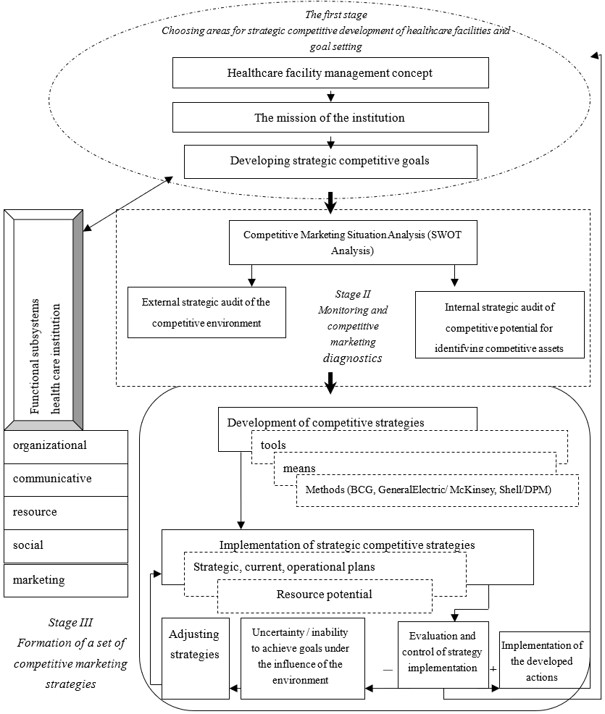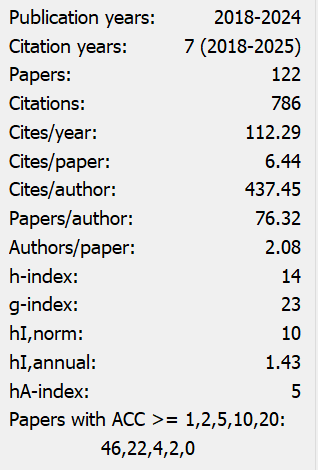Formation of an Innovative Competitiveness Management System of the Enterprise: On the Case of Ukraine's Healthcare
Abstract
In modern conditions, the priority task for Ukraine is the institutional transformation of the economy, the main purpose of which is to ensure sustainable socio-economic development. The article discusses the theoretical and methodological foundations and develops scientific and practical recommendations for the formation of an innovative competitiveness management system based on the example of healthcare institutions in Ukraine. Based on the analysis, the main characteristics of the innovative development of health care institutions are determined, interaction schemes for participants in the innovation process in the health care system and the mechanism for developing and implementing competitive strategies in the health care institution management system are developed. The calculation of the integral indicator of assessing the effectiveness of the use of labor resources as the most important component of assessing the level of competitiveness of an enterprise.
References
Akhlamov, A. H., & Kusyk, N. L. (2011). Health Economics and Financing: A Learning Method. tool. Odessa.
Andreeva, Y. L. (2009). A model for optimizing the implementation of scientific results in health care practice. Volgograd Bulletin. state. honey. universities, 4, 23-29.
Androshchuk, H. O., & Zhyliaiev, I. B., & Chyzhevskyi, B. H., & Shevchenko, M. M. (2009). Ukraine's Innovation Development Strategy for 2010-2020 in the face of globalization challenges. K: Parliamentary view.
Beliakov, V. K., & Pyven, D. V., & Antonov, D. P. (2008). On the problems of innovation policy in domestic health care and the need to create clusters of medical innovations. Management in Health, 3, 4-11.
Bell, M., & Pavitt, K. (1997). Technological accumulation and industrial growth: contrasts between developed and developing countries. W: D. Archibugi, J. Michie (red.). Technology, globalization and economic performance. Cambridge: Cambridge University Press.
Bilovodska, O. A. (2017). Marketing distributive and sales policy: research of essence, role and importance. Marketing and Manadgment of Innovations, 2, 85-97. http://doi.org/10.21272/mmi.2017.2-08
Bilynska, M. M. (2002). Methodology for Building a National Quality Management System for Higher Medical Education. Contemporary City Management, 7(9), 155-160.
Bodak, V. M. (2004). Problems of information support of processes of management of development of family medicine. Bulletin of Soc. hygiene and health organizations of Ukraine, 1, 72-77.
Bohdaniuk, I., Kolisnichenko, V., & Ustymenko, O. (2018). Audit as a form of control of the state financial inspection of Ukraine. Baltic Journal of Economic Studies, 4(5), 31-35. https://doi.org/10.30525/2256-0742/2018-4-5-31-35
Bruneel, J., Ratinho, T., Clarysse, B., & Groen, A. (2012). The evolution of business incubators: Comparing demand and supply of business incubation services across different incubator generations, Technovation, 32(2), 110-121. https://doi.org/10.1016/j.technovation.2011.11.003
Burkynskyi, B. V., Lazareva, E. V., & Aheeva, Y. N. (2002). Competitiveness of products and enterprises: Monohrafyia. Odessa: Institute of market problems and economical ecological researches of the NAS of Ukraine.
Byrher, E. V. (2007). Information and telecommunication technologies in health care. M.: Ritex.
Capello, R., Caragliu, A., & Nijkamp, P. (2009). Territorial Capital and Regional Growth: Increasing Returns in Cognitive Knowledge Use. Tinbergen Institute Discussion Paper. TI 2009-059/3. https://doi.org/10.2139/ssrn.1443830
Cepel, M., Stasiukynas, A., Kotaskova, A., & Dvorsky, J. (2018). Business Environment Quality Index in the SME Segment. Journal of Competitiveness, 10(1), 21-40. https://doi.org/10.7441/joc.2018.02.02
Cherunilam, F. (2010). International business: text and cases. New Delhi: PHI Learning Pvt. Ltd.
Edquist, C. (2004). Systems of Innovation – A Critical Review of the State of the Art. W: J. Fagerberg, D. Mowery, R. Nelson (red.), Handbook of Innovation. Oxford: Oxford University Press.
Feigenbaum, A. V., & Feigenbaum, D. S. (2009). The power of management innovation: 24 keys for sustaining and accelerating business growth and profitability. New York: McGraw-Hill.
Ivanová, E., & Čepel, M. (2018). The Impact of Innovation Performance on the Competitiveness of the Visegrad 4 Conutries. Journal of Competitiveness, 10(1), 54-72. http://dx.doi.org/10.7441/joc.2018.01.04
Karamyshev, D. V., & Nemchenko, A. S. (2006). Implementation and evaluation of the effectiveness of innovative projects in the healthcare system. Economy and State, 2, 86-88.
Ključnikov, A., Kozubíková, L., & Sopková, G. (2017). The Payment Discipline of Small and Medium-sized Enterprises. Journal of Competitiveness, 9(2), 45-61. https://doi.org/10.7441/joc.2017.02.04
Klymenko, S. M., Dubrova, O. S., Barabas, D. O., Omelianenko, T. V., & Vakulenko, A. V. (2006). Management competitiveness of enterprise. Retrieved from http://posibniki.com.ua/catalog-upravlinnya-konkurentospromozhnistyu-pidpriemstva---klimenko-sm
Ko, H., & Min, K. (2019). Determinants of social expenditures in post-socialist countries. Economics and Sociology, 12(2), 253-264. https://doi.org/10.14254/2071-789X.2019/12-2/15
Kozubikova, L., Kotaskova, A., Dvorsky, J., & Kljucnikov, A. (2019). The impact of political factors‘ perception on suitability of international business environment: The case of startups. Economics and Sociology, 12(1), 61-79. https://doi.org/10.14254/2071-789X.2019/12-1/3
Lepetiukha, N. V., & Rudska, I. O. (2016). The Integral Estimation of the Enterprise Functioning. Nikolaev National University of VA Sukhomlinsky. Business Economics and Management, 14, 424-429.
North, D. (1991). Institutions. Journal of Economic Perspectives, 5(1), 97-112. https://doi.org/10.1257/jep.5.1.97
Pashkov, V. D. (2006). State Policy for Social Innovation in Health. Pharmacy, 37(558). Retrieved from http://www.apteka.ua/article/3647
Porter, M. (2005). Competition; trans. with English. M.: Williams Publishing House.
Savchuk, A. V. (2001). A systematic approach to the analysis of the competitiveness of an industrial enterprise. Economist, 12, 58-61.
Skurativskyi, V. (2003). Humanitarian, social and economic priorities of innovative development of Ukraine. Bulletin of UADU, 2, 374-379.
Spasibo-Fatieieva, I. (2005). The Legal Aspect of Innovation in Ukrainian Realities. Bulletin of the Academy of Legal Sciences of Ukraine, 4, 15-23.
Tsymbaliuk, S. O. (2017). Determinants of personnel labor activity within the system of motivation. Actual problems of economics, 187, 264-272.
Tyukhtenko, N. A., & Makarenko, S. M. (2016). Economic and mathematic models for staff planning at enterprises of all ownership forms. Actual problems of economics, 175, 435-442.
Zachosova, N. (2019). Innovative approach in the estimatology of financial institutions economic security: possibilities of use in management and regulatory activity within the means of provision of the state financial security. Baltic Journal of Economic Studies, 5(2), 45-56. https://doi.org/10.30525/2256-0742/2019-5-2-45-56


This work is licensed under a Creative Commons Attribution 4.0 International License.
Copyright for this article is retained by the author(s), with first publication rights granted to the journal.
This is an open-access article distributed under the terms and conditions of the Creative Commons Attribution license (http://creativecommons.org/licenses/by/4.0/).


























